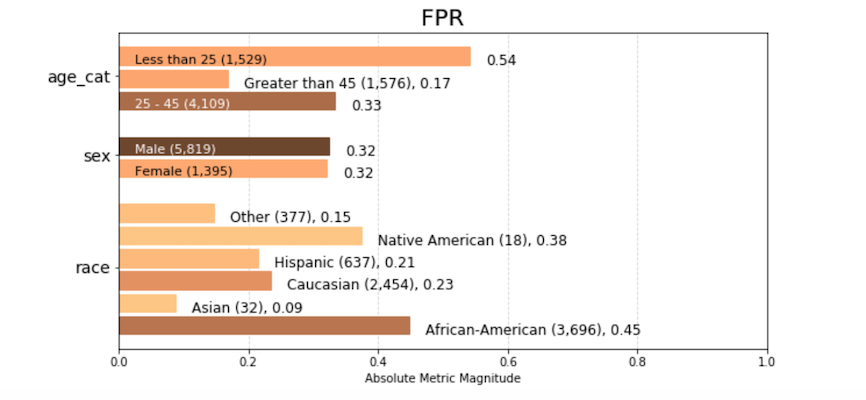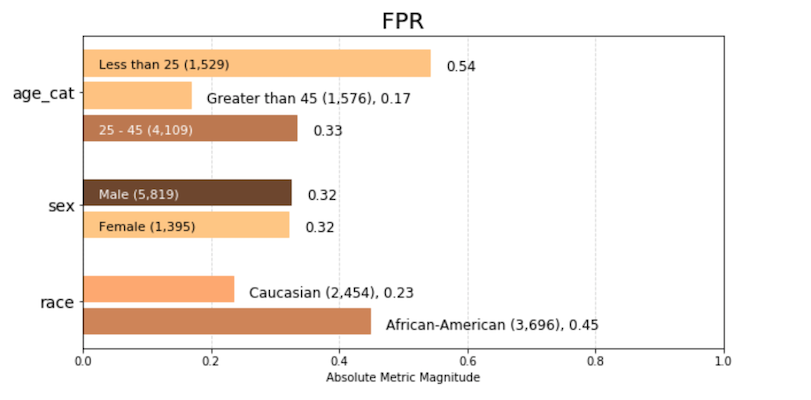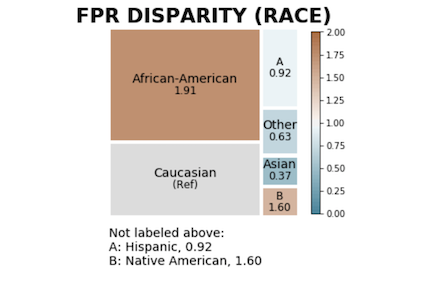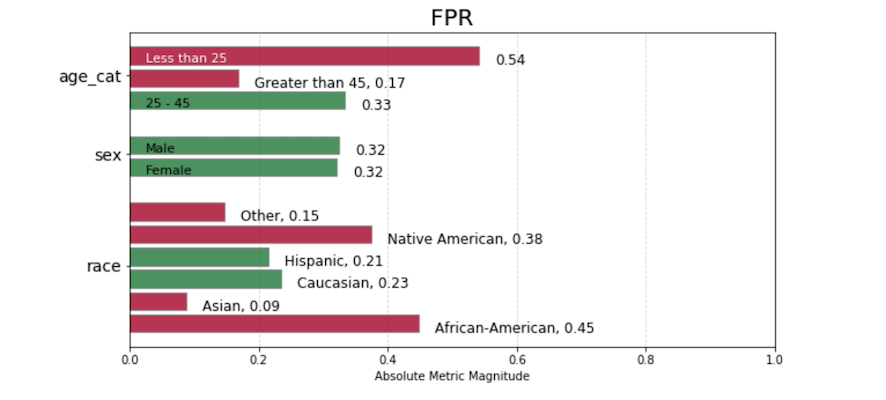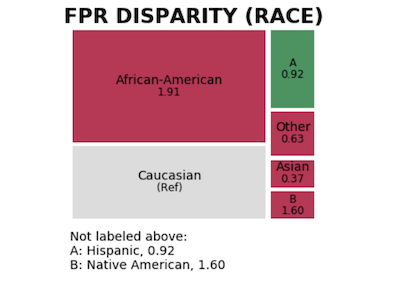Aequitas is an open-source bias audit toolkit for data scientists, machine learning researchers, and policymakers to audit machine learning models for discrimination and bias, and to make informed and equitable decisions around developing and deploying predictive tools.
Visit the Aequitas project website
Try out the Aequitas web application
Try out our interact colab notebook using the COMPAS dataset.
You can find the toolkit documentation here.
For usage examples of the python library, see our demo notebook from the KDD 2020 hands-on tutorial. Alternatively, have a look to COMPAS notebook using Aequitas on the ProPublica COMPAS Recidivism Risk Assessment dataset.
Aequitas is compatible with: Python 3.6+
Install Aequitas using pip:
pip install aequitas
If pip fails, try installing master from source:
git clone https://github.com/dssg/aequitas.git
cd aequitas
python setup.py install
(Note: be mindful of the python version you use to run setup.py)
You may then import the aequitas module from Python:
import aequitas
...or execute the auditor from the command line:
aequitas-report
...or launch the Web front-end from the command line (localhost):
python -m serve
To build a Docker container of Aequitas:
docker build -t aequitas .
...or simply via manage:
manage container build
The Docker image's container defaults to launching the development Web server, though this can be overridden via the Docker "command" and/or "entrypoint".
To run such a container, supporting the Web server, on-the-fly:
docker run -p 5000:5000 -e "HOST=0.0.0.0" aequitas
...or, manage a development container via manage:
manage container [create|start|stop]
To contact the team, please email us at [aequitas at uchicago dot edu]
Below are descriptions of the absolute bias metrics calculated by Aequitas.
Each bias disparity for a given group
is calculated as follows:
Python API
Detailed instructions are here.
To get started, preprocess your input data. Input data has slightly different requirements depending on whether you are using Aequitas via the webapp, CLI or Python package. See general input requirements and specific requirements for the web app, CLI, and Python API in the section immediately below.
If you plan to bin or discretize continuous features manually, note that get_crosstabs() expects attribute columns to be of type 'string,' so don't forget to recast any 'categorical' type columns!
from aequitas.preprocessing import preprocess_input_df
# double-check that categorical columns are of type 'string'
df['categorical_column_name'] = df['categorical_column_name'].astype(str)
df, _ = preprocess_input_df(*input_data*)The Aequitas Group() class creates a crosstab of your preprocessed data, calculating absolute group metrics from score and label value truth status (true/ false positives and true/ false negatives)
from aequitas.group import Group
g = Group()
xtab, _ = g.get_crosstabs(df)The Plot() class can visualize a single group metric with plot_group_metric(), or a list of bias metrics with plot_group_metric_all().
Suppose you are interested in False Positive Rate across groups. We can visualize this metric in Aequitas:
from aequitas.plotting import Plot
aqp = Plot()
fpr_plot = aqp.plot_group_metric(xtab, 'fpr')There are some very small groups in this data set, for example 18 and 32 samples in the Native American and Asian population groups, respectively.
Aequitas includes an option to filter out groups under a minimum group size threshold, as very small group size may be a contributing factor in model error rates:
from aequitas.plotting import Plot
aqp = Plot()
fpr_plot = aqp.plot_group_metric(xtab, 'fpr', min_group_size=0.05)The crosstab dataframe is augmented by every succeeding class with additional layers of information about biases, starting with bias disparities in the Bias() class. There are three get_disparity functions, one for each of the three ways to select a reference group. get_disparity_min_metric() and get_disparity_major_group() methods calculate a reference group automatically based on your data, while the user specifies reference groups for get_disparity_predefined_groups().
from aequitas.bias import Bias
b = Bias()
bdf = b.get_disparity_predefined_groups(xtab,
original_df=df,
ref_groups_dict={'race':'Caucasian', 'sex':'Male', 'age_cat':'25 - 45'},
alpha=0.05,
check_significance=False)Learn more about reference group selection.
The Plot() class visualizes disparities as treemaps colored based on disparity relationship between a given group and the reference group with plot_disparity() or multiple with plot_disparity_all(). Saturation is determined by a given fairness threshold.
Let's look at False Positive Rate Disparity.
fpr_disparity = aqp.plot_disparity(bdf, group_metric='fpr_disparity',
attribute_name='race')Now you're ready to obtain metric parities with the Fairness() class:
from aequitas.fairness import Fairness
f = Fairness()
fdf = f.get_group_value_fairness(bdf)You now have parity determinations for your models that can be leveraged in model selection! If a specific bias metric for a group falls within a given percentage (based on the fairness threshold) of the reference group, the fairness determination is 'True.'
To determine whether group False Positive Rates fall within the "fair" range, use Plot() class fairness methods:
fpr_fairness = aqp.plot_fairness_group(fdf, group_metric='fpr', title=True)To quickly review False Positive Rate Disparity fairness determinations, we can use Plot() class fairness_disparity() methods:
fpr_disparity_fairness = aqp.plot_fairness_disparity(fdf, group_metric='fpr', attribute_name='race')In general, input data is a single table with the following columns:
scorelabel_value(for error-based metrics only)- at least one attribute e.g.
race,sexandage_cat(attribute categories defined by user)
| score | label_value | race | sex | age | income |
|---|---|---|---|---|---|
| 0 | 1 | African-American | Female | 27 | 18000 |
| 1 | 1 | Caucasian | Male | 32 |
Back to 30 Seconds to Aequitas
The webapp requires a single CSV with columns for a binary score, a binary label_value and an arbitrary number of attribute columns. Each row is associated with a single observation.
Aequitas webapp assumes the score column is a binary decision (0 or 1).
This is the ground truth value of a binary decision. The data again must be binary 0 or 1.
Group columns can be categorical or continuous. If categorical, Aequitas will produce crosstabs with bias metrics for each group_level. If continuous, Aequitas will first bin the data into quartiles and then create crosstabs with the newly defined categories.
Back to 30 Seconds to Aequitas
The CLI accepts CSV files and accommodates database calls defined in Configuration files.
By default, Aequitas CLI assumes the score column is a binary decision (0 or 1). Alternatively, the score column can contain the score (e.g. the output from a logistic regression applied to the data). In this case, the user sets a threshold to determine the binary decision. See configurations for more on thresholds.
As with the webapp, this is the ground truth value of a binary decision. The data must be binary 0 or 1.
Group columns can be categorical or continuous. If categorical, Aequitas will produce crosstabs with bias metrics for each group value. If continuous, Aequitas will first bin the data into quartiles.
model_id is an identifier tied to the output of a specific model. With a model_id column you can test the bias of multiple models at once. This feature is available using the CLI or the Python package.
idmodel_identity_idrank_absrank_pct
Back to 30 Seconds to Aequitas
Python input data can be handled identically to CLI by using preprocess_input_df(). Otherwise, you must discretize continuous attribute columns prior to passing the data to Group().get_crosstabs().
from Aequitas.preprocessing import preprocess_input_df()
# *input_data* matches CLI input data norms.
df, _ = preprocess_input_df(*input_data*)By default, Aequitas assumes the score column is a binary decision (0 or 1). If the score column contains a non-binary score (e.g. the output from a logistic regression applied to the data), the user sets a threshold to determine the binary decision. Thresholds are set in a dictionary passed to get_crosstabs() of format {'rank_abs':[300] , 'rank_pct':[1.0, 5.0, 10.0]}. See configurations for more on thresholds.
This is the ground truth value of a binary decision. The data must be binary (0 or 1).
Group columns can be categorical or continuous. If categorical, Aequitas will produce crosstabs with bias metrics for each group_level. If continuous, Aequitas will first bin the data into quartiles.
If you plan to bin or discretize continuous features manually, note that get_crosstabs() expects attribute columns to be of type 'string'. This excludes the pandas 'categorical' data type, which is the default output of certain pandas discretizing functions. You can recast 'categorical' columns to strings:
df['categorical_column_name'] = df['categorical_column_name'].astype(str)model_id is an identifier tied to the output of a specific model. With a model_id column you can test the bias of multiple models at once. This feature is available using the CLI or the Python package.
idmodel_identity_idrank_absrank_pct
Back to 30 Seconds to Aequitas
Provision your development environment via the shell script develop:
./develop
Common development tasks, such as deploying the webapp, may then be handled via manage:
manage --help
If you use Aequitas in a scientific publication, we would appreciate citations to the following paper:
Pedro Saleiro, Benedict Kuester, Abby Stevens, Ari Anisfeld, Loren Hinkson, Jesse London, Rayid Ghani, Aequitas: A Bias and Fairness Audit Toolkit, arXiv preprint arXiv:1811.05577 (2018). (PDF)
@article{2018aequitas,
title={Aequitas: A Bias and Fairness Audit Toolkit},
author={Saleiro, Pedro and Kuester, Benedict and Stevens, Abby and Anisfeld, Ari and Hinkson, Loren and London, Jesse and Ghani, Rayid}, journal={arXiv preprint arXiv:1811.05577}, year={2018}}

